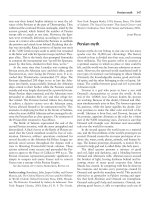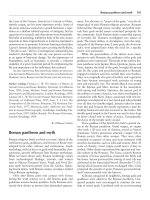Encyclopedia of world history (facts on file library of world history) 7 volume set ( PDFDrive ) 3233
Bạn đang xem bản rút gọn của tài liệu. Xem và tải ngay bản đầy đủ của tài liệu tại đây (64.82 KB, 1 trang )
predominantly in Sri Lanka with the goal of achieving
a separate state for the majority Tamil regions located in north and east Sri Lanka. The rebel group gains
much of its internal support from the Tamil agricultural workers and dislocated Tamil youths. Tamil Tiger
operations have targeted both military and political
objectives since the early 1970s. The United States, the
European union, Canada, and India all consider the
Tamil Tigers a terrorist organization. Under the leadership of its founder, Velupillai Prabhakaran, the LTTE
argues that they are freedom fighters.
Until the 1970s the Tamils insisted upon autonomy
but did not resort to violent methods. After a long period of attempts to negotiate, Tamils adopted the belief
that the Sinhalese-dominated Sri Lankan government
was unwilling to negotiate. A number of militant organizations were created—including the New Tamil Tigers
and the Liberation Tigers of Tamil Eelam. In 1979 the
LTTE began a campaign of attacking military targets,
including a July 1983 killing of 16 army soldiers that
led to the killing of thousands of Tamil civilians. In
response to the violence, LTTE membership dramatically increased. By 1984 the LTTE had begun higher
intensity attacks and created a naval unit called the Sea
Tigers. In 1987 a special elite unit of LTTE members
known as the Black Tigers was formed. By 2001 the
LTTE inexplicably dropped its call for a separate Tamil
state and reduced its demands to regional autonomy.
Norway negotiated a cease-fire, which as of mid-2006
was tenuous at best. In the summer of 2006 calls for a
“Final War” for Tamil Eelam independence emerged.
The LTTE, in addition to its military activities,
provides a host of government services. The LTTE’s de
facto government funds schools, hospitals, police stations, courts, and other municipal services. The LTTE
informal government operates under the precepts of
socialism. The LTTE also has a political wing, the Tamil
National Alliance, although formal attempts have not
been made by the LTTE to create political parties.
External support for the Tamil Tigers has come from
a number of Indian regimes. That support ended with
a LTTE associate’s assassination of Indian prime minister rajiv gandhi. In addition the international arms
of the Tamil Tigers, located in London and Paris, have
facilitated a number of purchases of weaponry. Funding
for activities originates in expatriate Tamil communities
in the West. Other fund-raising activities include extortion and illegal trade as well as legitimate business fronts
and charities. Many terror analysts note that part of the
Tamil network includes cargo ships. This has prompted
concerns over the use of the fleet in terror operations.
Tashkent Agreement
413
Very few Tamil rebels are captured alive. This is
because of a rigorous training regime that includes
political indoctrination emphasizing the importance
of not being captured. Hence Tamil recruits typically
wear a capsule of cyanide around their necks and are
encouraged to commit suicide rather than face capture.
In addition, the LTTE were one of the first modern terrorist groups to encourage suicide bombings. Much
has also been written concerning the LTTE practice of
recruiting children to fight in the rebellion. The rebel
organization has participated in both a conventional
war and attacks targeting civilians. The Tamil Tigers
have also been accused of ethnic cleansing. Specifically,
the Tamil Tigers attempted to remove all non-Tamil
residents from the Tamil state of Jaffna in 1990.
Further reading: Brogan, Patrick. World Conflicts: A Comprehensive Guide to World Strife since 1945. Lanham, MD:
Scarecrow Press, 1998; Bullion, Alan J. India, Sri Lanka
and the Tamil Crisis 1976–1994. New York: Pinter, 1995;
Laffin, John. The World in Conflict: War Annual 8. London: Brassey’s, 1997; O’Ballance, Edgar. The Cyanide
War: Tamil Insurrection in Sri Lanka, 1937–88. London:
Brassey’s, 1990.
Matthew H. Wahlert
Tashkent Agreement
The Tashkent Agreement of 1966 brought a temporary
end to the 1965 war between India and Pakistan and
was important subsequently in regulating negotiations
over the disputed territory of Kashmir.
The united nations (UN) had organized a ceasefire in 1965 when it became clear that the fighting had
the possibility of endangering large population centers.
After 17 days of fighting, neither side wished to resume
hostilities owing to the vulnerability of their people, the
lack of ammunition and supplies, and the lack of war
goals that could be held. Arms suppliers in the United
States and the United Kingdom as well as in China were
unwilling to provide more weapons. Consequently, all
parties were amenable to finding a means of diplomatically resolving the confrontation.
Soviet prime minister Alexei Nikolaevich Kosygin
invited both sides to a conference at Tashkent in the
southern Soviet Uzbek Republic. The subsequent agreement was signed by the president of Pakistan, mohammad ayub khan, and the Indian prime minister, lal
bahadur shastri, on January 10, 1966. Unfortunately,









